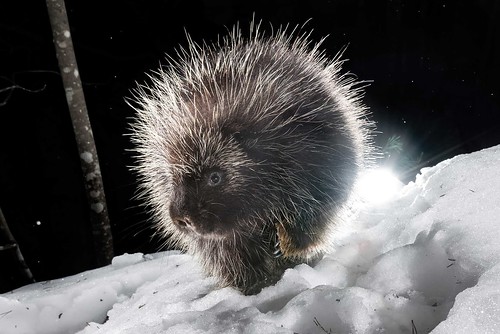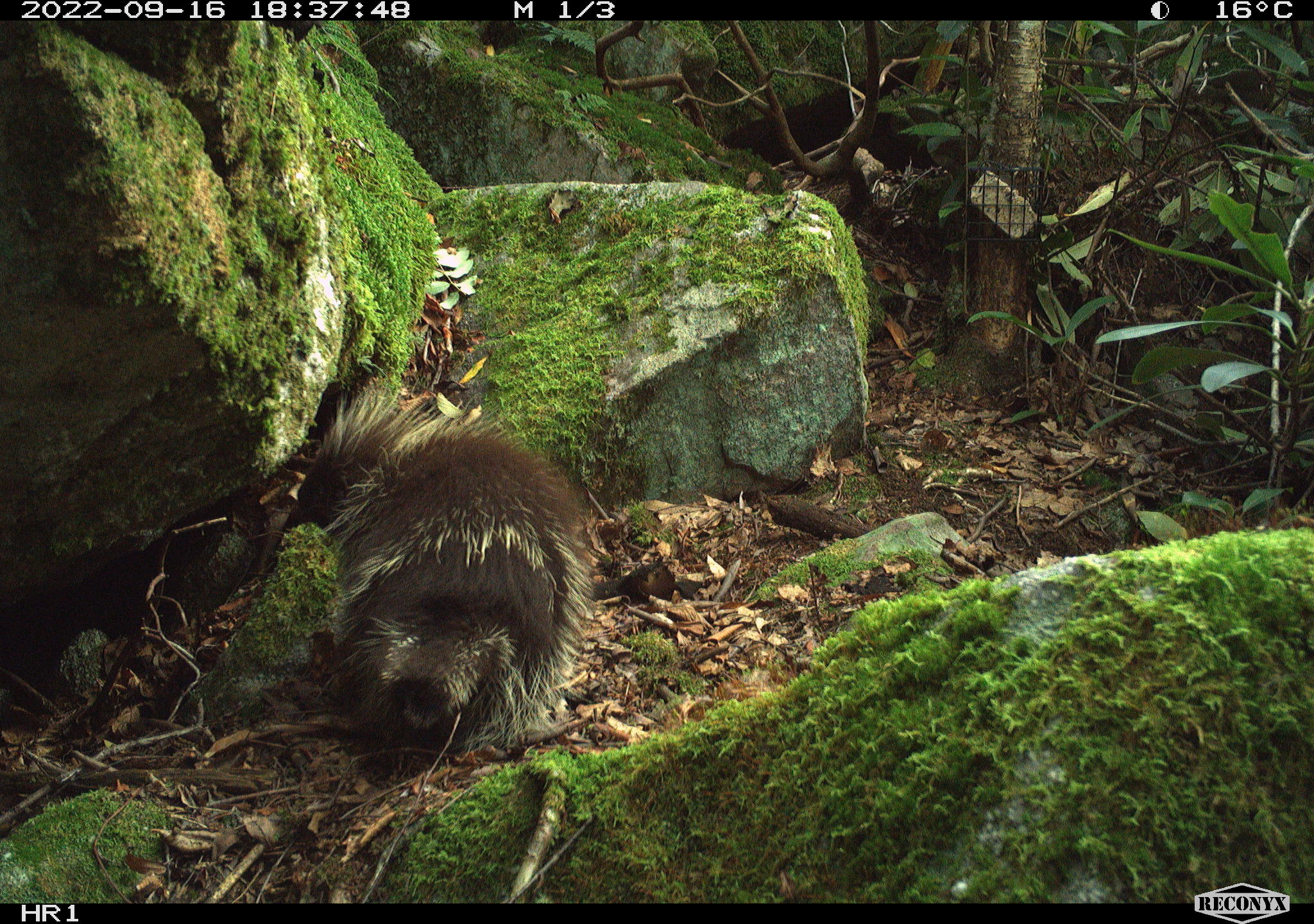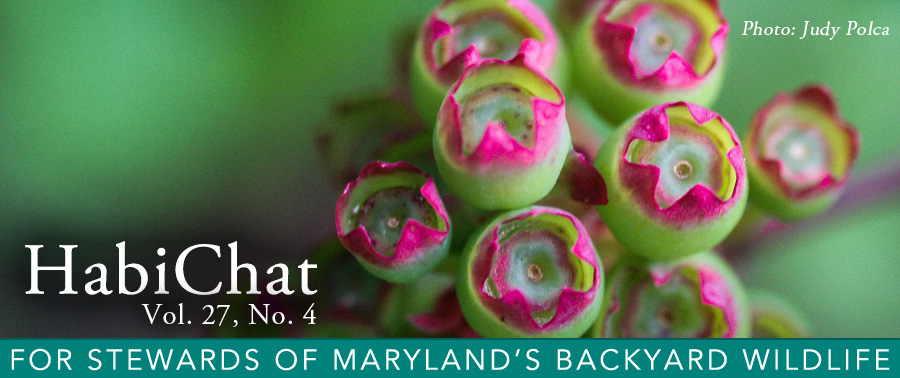Native Animal Profile: North American Porcupine

Photo by Nathaniel Peck, submitted to the 2023 Maryland DNR Photo Contest.
The subject of this native animal could come right out of a horror movie! It only comes out at night; it has barbed, dagger-like spikes all over its body; its huge, orangey-red front teeth are sharp enough to chisel into wood; and its courtship shrieks and groans are truly the stuff of nightmares. The North American porcupine is our second-largest rodent (after beavers), weighing in at as much as 20-35 pounds in older individuals.
Found only in the western part of our Maryland, local porcupine populations have made a remarkable comeback, being down-listed from Endangered to In Need of Conservation status in 1980, and then delisted entirely in 2014. In recent years, porcupines have continued to reproduce successfully and expand into historically used habitats in our state. Still, due to habitat loss and needing to share space with a lot of humans, they are at risk of decline. As such, porcupines are considered a “watchlist” species; in other words, our scientists at the Natural Heritage Program are keeping an eye on populations to be sure they stay stable.
 So what is this prickly critter up to in fall? Courtship and mating, of course! Dating in the porcupine world is quite elaborate and a bit gross, including extensive vocalizations, some dancing, fights between rival males, and the male showering the female in urine. The female is pregnant for one of the longest gestation periods in the rodent world, around 7 months, and gives birth in the spring to just one young, called a porcupette. Fortunately for the mother, baby porcupines are born with all their hair softened. Within one hour after birth, porcupettes have hardened quills and fully functional eyes, teeth, and claws, allowing them to join their arboreal mothers in the trees almost immediately. They are vegetarian and mostly solitary, munching on leaves in the growing season, and then enjoying bark and twigs throughout the winter. Studies have shown that they are “foodies” of the forest, extremely selective to maximize nutritional content, but also adaptable to varying conditions. Do you experience intense cravings for salty foods at this time of year? Then you have something in common with a porky. For them, this may be due to the loss of eastern hemlock trees from the invasive wooly adelgid insect or a depletion of food sources high in sodium as plant communities transition for winter. Whatever the cause, the salt-seeking behavior can make porcupines act quite destructively in human communities, chewing on anything a sweaty hand may have touched, licking at road salt, or even going after some man-made glues.
So what is this prickly critter up to in fall? Courtship and mating, of course! Dating in the porcupine world is quite elaborate and a bit gross, including extensive vocalizations, some dancing, fights between rival males, and the male showering the female in urine. The female is pregnant for one of the longest gestation periods in the rodent world, around 7 months, and gives birth in the spring to just one young, called a porcupette. Fortunately for the mother, baby porcupines are born with all their hair softened. Within one hour after birth, porcupettes have hardened quills and fully functional eyes, teeth, and claws, allowing them to join their arboreal mothers in the trees almost immediately. They are vegetarian and mostly solitary, munching on leaves in the growing season, and then enjoying bark and twigs throughout the winter. Studies have shown that they are “foodies” of the forest, extremely selective to maximize nutritional content, but also adaptable to varying conditions. Do you experience intense cravings for salty foods at this time of year? Then you have something in common with a porky. For them, this may be due to the loss of eastern hemlock trees from the invasive wooly adelgid insect or a depletion of food sources high in sodium as plant communities transition for winter. Whatever the cause, the salt-seeking behavior can make porcupines act quite destructively in human communities, chewing on anything a sweaty hand may have touched, licking at road salt, or even going after some man-made glues.
As you can imagine, only the cleverest of carnivores can catch and consume a porcupine – their quills and skilled defensive maneuvers serve them well (which do not include throwing quills, but do include emitting a stinky odor). Injuries from porcupine quills have been known to cause death in potential predators, as the stiff, barbed, modified hairs can slowly work their way into tissue and cause infections. Very determined animals, like the fisher, will circle a porcupine and repeatedly attack its face until it wears the animal into exhaustion, at which point flipping it over to access the quill-less belly is the key move. In a fascinating adaptation, porcupine quills have been found to be coated in free fatty acids, which serve as a topical antibiotic. This greasy coating prevents the growth of bacteria and reduces the risk of infection should a porcupine ever accidentally stab itself when it falls from a tree.
What can we as homeowners and neighbors do to support the North American porcupine? For starters, prevent unpleasant porcupine interactions by keeping salty substances out of their reach. Keep your dog leashed on walks in the western Maryland counties, protecting them from any possible interaction with a prickly porky, as the consequences can mean very expensive veterinary bills and a lot of pain for everyone involved. Should you encounter a sick, injured, or particularly determined nuisance porcupine, visit our nuisance wildlife page for next steps. Have open space in your yard? Plant native trees that porcupines like, such as hemlock, sugar maples, and pines.


 1-888-373-7888
1-888-373-7888 233733
233733